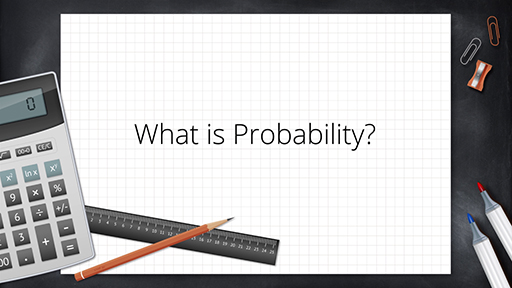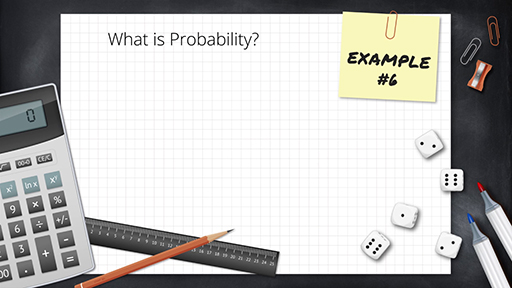1 Dealing with uncertainty: an introduction to probability
Allow approximately 1 hour 30 minutes to complete this section.
Decision-making is often undertaken in an uncertain world. That is, you might have some doubts about the reliability of the data you have been provided with, as well as the future environment in which you will be operating. In business, uncertainty regarding the future can cover a very wide range of scenarios, including:
- political – who will be running the country in five years’ time? What will be their view on, for example, tax, regulation, etc.?
- economic – will the country be in recession, or booming? What will interest rates be?
- market – how will your product market develop? Will there be new entrants, leavers or substitutes?
As decision-makers, you need to find strategies to deal with uncertainty and so, in this section, you will be introduced to the topic of probability.
A knowledge of probability enables you to assess the likelihood of something happening. For example, what is the chance that a 55-year-old person will buy a new car in the next 12 months?
You might subdivide the data – what is the probability that a 55-year-old man will buy a car within the next 12 months?
You can then go further by attaching conditions. For example, what is the probability that a 55-year-old man, who bought his last car three years ago, will buy a new car within the next 12 months?
Or even, if a 55-year-old man has purchased a new car within the last three years, how long will it be before he buys a new car?
Unfortunately, probability theory is quite a complex subject and so in this course you will only consider the most basic ideas. These ought to suffice for the kinds of decisions that managers need to make most of the time. In the next activity you will be introduced to those basic ideas.
Activity 1 What is probability?
In Videos 1 and 2, you will be introduced to the basic ideas of probability. An understanding of probability allows you to quantify uncertainty.
You will build on your understanding of probability, especially later on in this course when you learn about decision trees. So you may need to watch Videos 1 and 2 a few times until you feel comfortable with how probability starts to address the question of how to deal with uncertainty in decision-making.
Part 1
Watch Video 1. You may like to make notes in the text box below.

Transcript: Video 1 An introduction to probability: part 1
Part 2
Watch Video 2. You may like to make notes in the text box below.

Transcript: Video 2 An introduction to probability: part 2
Discussion
From Video 2 you learnt that probability is a way of measuring uncertainty. The probability of an event may be taken as the proportion of times that an event can occur out of the total possible events. The video provided some simple examples of how you might estimate a probability.
Most people will have an instinctive feel for what probability is. Probability is a measure of how likely it is that something will occur. How might you assess that likelihood?
Probability: first principles
To begin, you might be able to derive a number from first principles.
For example, it is hopefully obvious that if someone throws a ‘normal’ six-sided die, the number ‘3’ is likely to land face up 1 in 6 times. You might say that the probability of throwing a ‘3’ is , or one sixth.
Of course, if someone throws a die six times then they might get ‘3’ more than once or even no ‘3’s. It is only if the die is thrown thousands of times that the person will notice that roughly one sixth of the throws result in a ‘3’ landing face up.
Probability: considering past behaviour
Another way of arriving at a probability might be to observe past behaviour. For example, the Eurovision song contest has, as of April 2019, had 66 winners (some years there have been joint winners). The Republic of Ireland has won it seven times. So you might conclude that the Republic of Ireland has a probability of winning the next contest. Coming to such a conclusion is, of course, rather simplistic. You would need to consider how much past success indicates the chance of future success, given that the performers are usually different.
Probability: subjective opinion
One last way you might assign a probability is through simply expressing a subjective opinion. For example, if you watch the Eurovision performers prior to voting, you might arrive at a view of which act is most likely to appeal to the voters (nowadays, a combination of the public and appointed judges). Of course, this probability might be very different to that assigned by another watcher.
The concept of probability could also be used to consider how the gambling industry functions and the interplay between odds and subjective probabilities, but this will not be covered in this course.
In business scenarios, it is not often that you can rely on the first approach of deriving a number from first principles of probability only. More often, you have to arrive at a probability based on a combination of some data (via a market survey, for example) and experience.
Before proceeding, the definition and mathematical rules for probability need to be explained. From the die example earlier, a reasonable definition of a probability can be concluded as follows:
Probability is expressed as a ratio whose value is positive. You cannot have negative probabilities.
A probability is less than or equal to 1. This means that a probability cannot exceed 1.
The total of all probability outcomes must equal 1.
For example, if the probability of something happening is 0.45, the probability of it not happening must be .
In the next section you will have the opportunity to check your understanding of probability.
